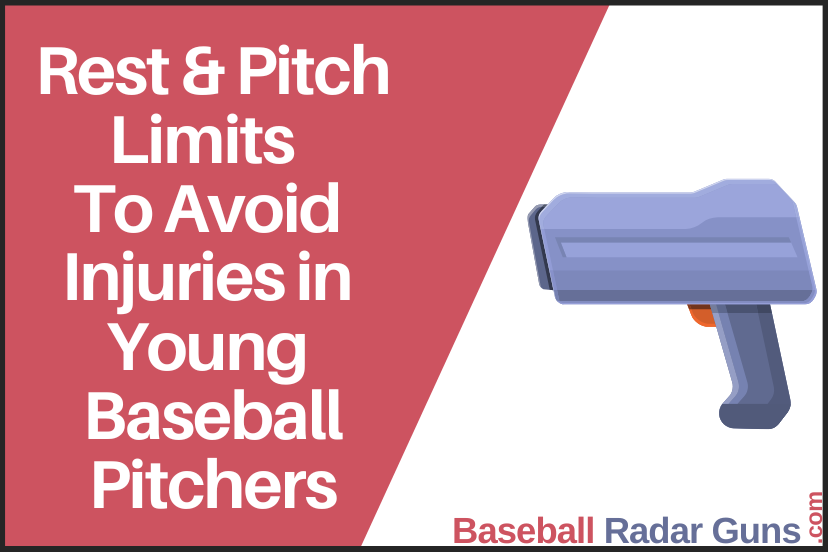Rest and Pitch Limits To Avoid Injuries in Young Baseball Pitchers
*We may earn a commission for purchases made using our links. Please see our disclosure to learn more.
Young baseball pitchers face unique challenges when it comes to avoiding injuries. Because they are still growing, their bones, muscles, and tendons can be particularly susceptible to damage. One common issue is growth plate injuries, which occur when the area of growing tissue near the ends of long bones is damaged. These injuries can lead to significant pain and even long-term damage if not addressed carefully.
Shoulder pain is another frequent complaint among young pitchers. This can often be traced back to overuse, which places extraordinary stress on the shoulder joint. Without adequate rest, these young athletes risk chronic pain that might require lengthy recovery times.
Rotator cuff problems can sometimes appear in young pitchers, surprisingly linked to poor throwing mechanics or too much strain. This is an area in the shoulder with several muscles and tendons that work together to stabilize the joint, and issues here can mean big trouble down the line if not tackled with proper care right away.
Then there’s the dreaded UCL (Ulnar Collateral Ligament) injury. It’s the stuff of nightmares for many pitchers. The repetitive stress of pitching often causes it. If a young pitcher complains of inner elbow pain, it’s time to take it seriously. Getting advice from trained sports professionals early can make a difference in preventing serious outcomes.
Ensuring that young pitchers don’t fall into these injury traps starts with awareness and education that involves everyone—from the athlete to the coaches and the parents. It’s about building a supportive ecosystem that prioritizes the health and wellness of these young players above the pressure to perform.
Table of Contents
The Importance of Rest in Developing Young Athletes
Rest isn’t just a downtime; it’s a critical part for any athlete’s schedule, especially young pitchers. Rest is where the magic happens. It’s when muscles repair, strength builds, and energy stores are replenished. For growing kids, rest is as much about healing as it is about growing and fortifying their developing bodies.
Taking time to rest helps prevent the stress injuries many young pitchers face by allowing their arm and shoulder muscles a break from the constant pressure of throwing. Overuse is a major contributor to injuries, and by simply adding rest days into a training regime, we can significantly reduce this risk.
Rest also plays a massive role in mental health. Young athletes often face pressure from school, family, and their sport all at once. By allowing a bit of breathing space through rest days, they can take a step back, reducing stress and preventing burnout. This mental space can cultivate a more passionate and engaged player who isn’t playing through exhaustion or frustration.
Then there’s the support system – parents, coaches, and health professionals all need to be on the same page. Consistency in messaging helps ensure that kids know rest is not optional but rather an essential part of their growth and success.
Personal stories often illustrate the point best. Many young baseball pitchers have thrived once rest became a priority. Coaches and parents have shared how their athletes began to show improvements not only in performance but also in their overall attitude towards the sport. Emphasizing rest teaches kids a fundamental lesson about self-care and listening to their bodies, setting them up for a healthier sporting career and life beyond.
Understanding and Implementing Pitch Limits
In the world of youth baseball, pitch limits have become a crucial strategy for preventing injuries. By limiting the number of pitches a young player can throw in a game or practice, we can significantly minimize the risk of overuse injuries that plague many developing athletes.
Pitch limits aren’t just random numbers; they’re carefully calculated based on age and skill level. This strategy is based on research, focusing on how much stress growing arms can handle without leading to serious issues. Following these guidelines ensures that young pitchers have enough rest and recovery time to repair muscles and stay fresh for their futures in the sport.
For parents and coaches, the challenge is not just to know these limits but to implement them effectively. It involves keeping track of pitches, whether in practice or games, and making sure young players adhere to these limits even when they feel they can go on. It requires a community effort where the coach acts as a guide, the parent ensures discipline, and the athlete learns responsibility.
Expert opinions strongly support pitch limits as part of an injury prevention program. Many have witnessed firsthand the turnaround when teams start taking these limits seriously. There’s a noticeable decrease in injuries and a boost in performance as pitchers stay healthier and stronger throughout the season.
Families that insist on pitch limits often see tangible results. Kids enjoy the game more when they’re propelled by passion rather than pressure. Adhering to limits doesn’t hold back talent; it safeguards it, ensuring these young athletes can continue to grow and thrive without hitting unnecessary bumps or health scares along the way.
Building a Comprehensive Injury Prevention Program
Creating an effective injury prevention program for young baseball pitchers is about more than just enforcing rest and pitch limits; it’s about a holistic approach that covers all aspects of a young athlete’s development. Conditioning, for instance, plays a vital role. Proper exercises build core strength, improve flexibility, and ensure that all muscle groups are equally developed, which can significantly reduce the risk of injuries.
Technique refinement is another cornerstone. Many injuries stem not from overuse alone, but from improper throwing mechanics. Hiring coaches or specialists who understand the intricacies of baseball pitching can help young athletes alter their form, ensuring they’re not putting undue stress on their arms or shoulders.
Successful programs aren’t just something cooked up on paper. They’re living, breathing plans implemented by teams at leading baseball academies and leveraged by sports organizations everywhere. These institutions have witnessed how a well-tailored program that includes conditioning, nutrition, hydrating well, and focused skills training can lead to fewer injuries and better overall performance.
For these programs to be impactful, collaboration is key. It draws in expertise from various fronts—coaches, healthcare professionals, and families—all working in concert to create a nurturing environment for the athlete. Each group plays a role in monitoring the athlete’s condition, adjusting their regimen as needed, and offering support when challenges arise.
Adopting comprehensive injury prevention programs offer long-term benefits. Athletes often extend their careers as they avoid the pitfalls of recurrent injuries. They enjoy their sport longer, perform at higher levels, and suffer fewer chronic problems. It’s about building not just athletes but healthy individuals who carry these lessons and practices beyond the playing field into all aspects of their lives.
Conclusion
Preventing injuries in young baseball pitchers requires a holistic approach, including proper rest, pitch limits, and refined mechanics. By prioritizing their health and fostering a supportive environment, we can help these athletes thrive both on and off the field. If you’re interested in exploring the best radar guns available in 2025 to enhance training and performance, visit BaseballRadarGuns.com for expert reviews and recommendations.




